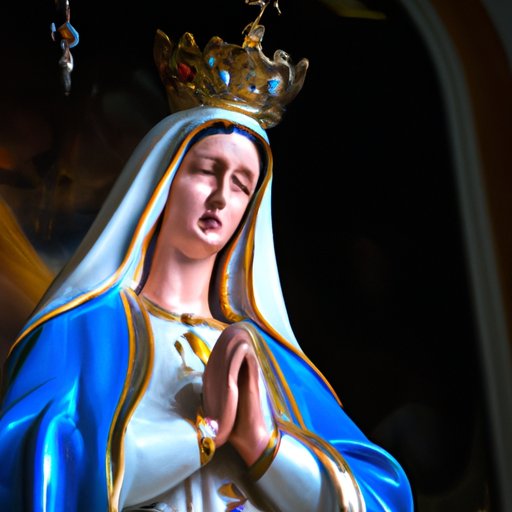Introduction
If you’re curious about Catholicism, you’ve come to the right place. Whether you’re considering converting to the faith or just want to understand its beliefs and practices better, this article is for you. In this Beginner’s Guide to Catholicism, we’ll explore the key beliefs, history, social teachings, and controversies surrounding the Catholic Church.
The Catholic faith is the largest branch of Christianity. It has more than a billion followers around the world, and its teachings have had a significant impact on the history of Western civilization. Although there are many diverse expressions of Catholicism, there are some core beliefs and practices that unite Catholics across the world and throughout time.
A Beginner’s Guide to Catholicism
Catholicism is centered on belief in the Trinity, the idea that God is one God in three persons: the Father, the Son (Jesus Christ), and the Holy Spirit. Catholics believe that Jesus is the Son of God who took on human flesh and came to earth to save humankind from sin. They also believe that salvation comes through faith in Jesus and good works.
Central to Catholicism is the belief in the Eucharist, the sacrament in which bread and wine become the body and blood of Christ during Mass. Catholics also have a strong devotion to Mary, the mother of Jesus and the “Queen of Heaven.” Other sacraments include baptism, confirmation, reconciliation, anointing of the sick, marriage, and holy orders.
Catholics observe many traditions and practices, including the liturgical calendar, which marks the seasons of the Church year. They also celebrate the Mass, which includes readings from the Bible, prayers, and the Eucharist. Catholics also have a rich history of religious art, music, and architecture, which can be seen in churches, cathedrals, and museums around the world.
History of the Catholic Church
The Catholic Church can trace its origins back to the time of Jesus and the apostles. Over the centuries, the Church evolved and grew, becoming a major force in the world. The Middle Ages saw the rise of powerful Popes and the establishment of monastic orders like the Benedictines and Franciscans. In the 16th century, the Protestant Reformation led to a split in the Church and the creation of many new Christian denominations.
The Catholic Church has gone through many changes in recent years, particularly with the Second Vatican Council (Vatican II) in the 1960s. Vatican II led to a modernization of the Church, including changes to the liturgy, a greater emphasis on social justice, and more engagement with other religions.
The Role of Mary in Catholicism
Mary has a special place in Catholic theology and devotion. Catholics believe that she was chosen by God to be the mother of Jesus, and as such, she is revered as the most holy woman and the model of Christian discipleship. Catholics also believe in several dogmas about Mary, including her Immaculate Conception (that she was born without sin) and her Assumption (that she was taken body and soul into heaven).
Many Catholics have a personal devotion to Mary, praying the Rosary and invoking her intercession in times of need.
Catholic Social Teachings
Catholicism has a rich tradition of social justice teachings. From the earliest days of the Church, Christians have been called to care for the poor and working for a more just society. Catholic social teaching is based on the ideas of human dignity, the common good, subsidiarity, and solidarity.
Catholic social teaching addresses issues such as poverty, immigration, environmental degradation, and economic justice. Catholics are called to see Christ in all people and to work for the common good. Many Catholic organizations work for social justice around the world, including Catholic Relief Services, Catholic Charities, and Caritas Internationalis.
Exploring the Sacraments of the Catholic Church
The Catholic Church has seven sacraments, each of which signifies a key moment in the Christian life. Baptism marks a person’s entry into the Church, while Confirmation strengthens their faith. Reconciliation is the sacrament of forgiveness, and anointing of the sick is for those who are ill or dying. Marriage is the sacrament of love and commitment, while holy orders is for those called to serve the Church as priests, deacons, or religious.
The Eucharist is the sacrament at the heart of Catholic worship. During Mass, the bread and wine become the body and blood of Jesus Christ. Catholics believe that the Eucharist is the source and summit of their faith.
The Controversies Surrounding the Catholic Church
The Catholic Church has faced many challenges in recent years, including sexual abuse scandals and disagreements over doctrine. The Church has been criticized for its handling of abuse cases, and there have been calls for greater accountability and transparency in the Church’s hierarchy.
There have also been debates over Church teachings, particularly on issues related to sexuality and gender. Many Catholics have disagreed with the Church’s stance on issues such as contraception, abortion, and homosexuality.
A Day in the Life of a Catholic Priest
To better understand the life and work of Catholic priests, it’s helpful to consider a typical day in a priest’s life. Priests are responsible for leading Mass, hearing confessions, and performing various other duties in their parish communities. They also spend time praying and studying, as well as meeting with parishioners and working on various pastoral projects.
Although the priesthood can be a challenging and demanding vocation, priests also find great joy and fulfillment in their work. They serve as spiritual guides, mentors, and friends to the members of their parish communities.
Conclusion
Catholicism is a rich and complex faith that has had a profound impact on the world. From its beliefs in the Trinity and the Eucharist to its social justice teachings and devotion to Mary, there is much to explore and appreciate about the Catholic Church. Although there are many challenges and controversies facing the Church today, Catholics around the world continue to find meaning, purpose, and community in their faith.
